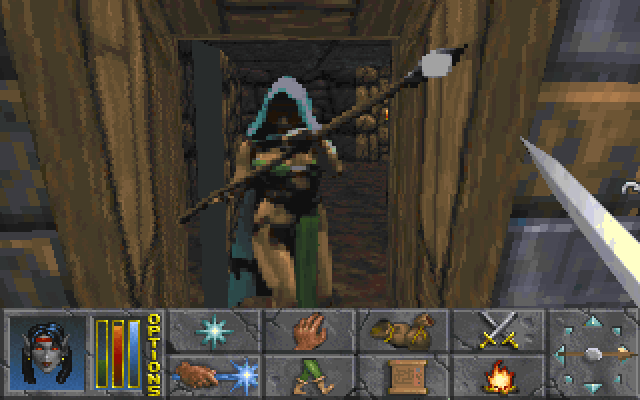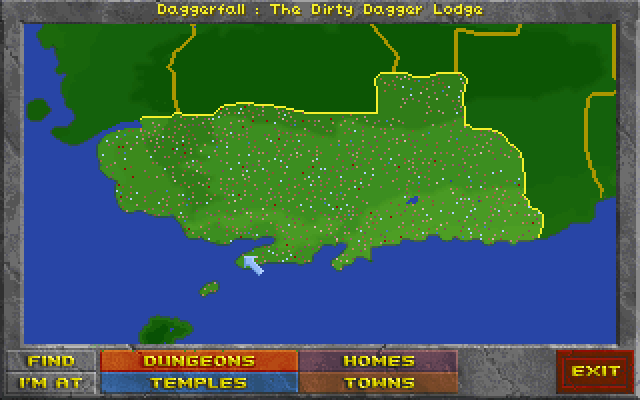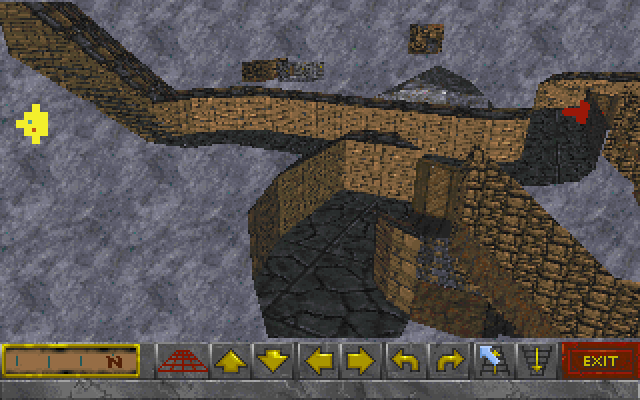The evolution of The Elder Scrolls
How The Elder Scrolls series went from gladiators to Dragonborn.

The Elder Scrolls II: Daggerfall (1996)
There were two ways to make a character in Arena. You could choose a class from a list of 18, or have one chosen for you after filling out a questionnaire like a cross between the quandaries at the start of Ultima IV and the Voight-Kampff test from BladeRunner. Daggerfall adds the option to create your own class, as well as a second set of interview questions to determine your background, asking about your childhood nickname, motivation for seeking adventure, and so on. As well as influencing starting skills, these answers were incorporated into the player’s journal to create a backstory for who they were before being roped into helping the Emperor with his latest problem. From the start Daggerfall aimed for a higher level of detail than Arena.
To achieve that it shrunk in scope from an entire continent to two provinces, High Rock and Hammerfell, which is still massive compared to the later games. The world map is so intimidating, each town and dungeon a single pixel, that there’s a search function without which you’d never find anything. Although fast travel is still a necessity for getting around because it takes hours to walk anywhere, it is possible to trudge from one location to the next even if you see the same trees and mushrooms a hundred times in between. Some locations, like the witches’ covens, are almost impossible to find except by stumbling across them this way.

To get to that overworld though, players have to survive the beginning. Although Arena and Daggerfall are both games in the then-popular ‘good luck surviving the starter dungeon’ genre, adding more options to character creation in Daggerfall made it even easier to create a hero who’s ill-equipped to face the brutal beginning, a dungeon where resting can summon grizzly bears and there are enemies who can’t be harmed by mundane weapons.
Escape to the city of Daggerfall, as the tutorial suggests before promptly breaking and never reappearing, and things change. While the streets are still on a 1:1 scale, making travel from one shop to the next take minutes, the people on those streets have a lot more to say. Reviews of Arena had said things like “NPC interaction is rather lifeless”, but in Daggerfall there’s a bewildering variety of conversation topics to choose from and different answers based on whether you ask bluntly or politely. Many characters belong to factions, and completing sidequests for them increases your reputation with those factions—another layer of complexity aimed at giving life to the NPCs.

The NPCs still draw their answers from a common pool that repeated quickly, but the intent was clearly to address one of Arena’s flaws. Another criticism of Arena’s towns was that wandering monsters infested them at night, gangs of skeletons stalking the streets like they were auditioning for Westeros Side Story. In Daggerfall, there’s an explanation for this: the ghost of King Lysander and his army of wraiths haunt the city, moaning “VENGEANCE!” and driving everyone into well-lit taverns for safety.
Every city has guilds, and now they’re joinable and have quests associated with them. There are secret guilds too—pick enough pockets and the Thieves Guild will recruit you, murder innocents and the Dark Brotherhood will be impressed, get bitten by a vampire and their brethren will be in touch. Summoning the pagan Daedra triggers quests for artifacts that would recur throughout the series, like Azura’s Star and the madgod’s staff Wabbajack. These side stories are richer than Arena’s, but also more likely to break. NPCs you need to interact with might not spawn, and the math behind the random dungeons that sidequests send you to sometimes place objectives in inaccessible rooms.

Where dungeons were Arena’s strong point, they’re Daggerfall’s weakest. Twisting staircases and angled floors make for jumbled geographies that turn the automap into an eyeboggling mess: rotatable 3D sculptures that look like they were drawn by M. C. Escher. It’s easy to get stuck on objects or fall through the floor, which happened so frequently a keyboard shortcut was added to teleport players to their last stable position (Alt-F11 if it happens to you). Other bugs let arrows fly through walls and doors, transformed the sound of torches into an angry buzz, and sometimes made the main questline impossible to complete. While Arena wasn’t free of bugs either—notably reloading the same save too often would cause a crash, and sometimes so would simply attacking with fists—Daggerfall became infamous for its bugginess and gave Bethesda a reputation that’s stuck with it to this day.
Keep up to date with the most important stories and the best deals, as picked by the PC Gamer team.
Yet even though Daggerfall was unfinishable for many players, Bethesda took its endings seriously. Part of the overall goal of adding to the variety of options included having six different endings, allowing the player to choose who to side with. Rather than have one be the canonical conclusion, books in later games referred to a mystical event called ‘The Warp in the West’ that allowed all six of them to happen simultaneously. It was Daggerfall that added these readable books to the series, filling them with history and legends, jokes and songs. The Elder Scrolls’ background was becoming richer and stranger.

Jody's first computer was a Commodore 64, so he remembers having to use a code wheel to play Pool of Radiance. A former music journalist who interviewed everyone from Giorgio Moroder to Trent Reznor, Jody also co-hosted Australia's first radio show about videogames, Zed Games. He's written for Rock Paper Shotgun, The Big Issue, GamesRadar, Zam, Glixel, Five Out of Ten Magazine, and Playboy.com, whose cheques with the bunny logo made for fun conversations at the bank. Jody's first article for PC Gamer was about the audio of Alien Isolation, published in 2015, and since then he's written about why Silent Hill belongs on PC, why Recettear: An Item Shop's Tale is the best fantasy shopkeeper tycoon game, and how weird Lost Ark can get. Jody edited PC Gamer Indie from 2017 to 2018, and he eventually lived up to his promise to play every Warhammer videogame.

